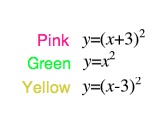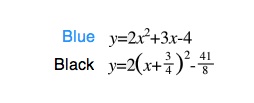

Assignment #2
Transforming Parabolas
by
Angela Wall
Graph the parabola
y = 2x2 + 3x - 4
a. Overlay a new graph replacing each x by (x - 4).
b. Change the equation to move the vertex of the graph into the second quadrant.
c. Change the equation to produce a graph concave down that shares the same vertex.
Below is the graph of y = 2x2 + 3x - 4.

Part A: Overlay a new graph replacing each x by (x - 4).


When the x in the original equation is replaced by (x - 4), the graph of the function shifts horizontally by four units. In other words, the graph is moved to the right four units.
Shifting the graph to the right might seem counterintuitive because one might think subtracting a value would shift the graph left, towards the negative values on the x-axis. One way to think about horizontal shifts is to consider what has to be done to the function in order to center it about the origin. For example, we know that (x - 3)2 shifts the graph of x2 to the right 3 units. So, 3 units would need to be subtracted to move the function’s vertex back to the origin. Or, (x + 3)2 shifts the graph of x2 to the left three units, meaning 3 units would need to be added to move the function’s vertex back to the origin. Another way to think about it is to see what value for x would make the function equal to zero. When that is found, the vertex of the function can be graphed. So with (x + 3)2, x = -3 would make the function equal to zero, meaning the vertex of the function would be at x = -3. Observe the graphs below for the functions (x + 3)2, x2, and (x - 3)2.


Part B: Change the equation to move the vertex of the graph into the second quadrant.
In order to move the graph of y = 2x2 + 3x - 4 into the second quadrant, the graph will need to be shifted upwards. To do this, a value large enough will need to be added to the equation to move it into the second quadrant. Below, 6 is added to the equation, moving the vertex of the parabola up 6 units.


How do we know the vertex of original parabola was shifted up 6 units? First we will need to find the vertex of the original equation. The vertex of a quadratic functions is written as (h, k) where h = -b/2a and k is the value found by plugging in the value of h into the general form of the original quadric equation. (Note: the general form for a quadratic equation is y = ax2 + bx + c). For this quadratic, a = 2, b = 3, and c = -4. So, h = -3/(2*2) = -3/4. Plugging this back into the equation for x, we get k = -41/8. Thus, the vertex is at (-3/4, -41/8). Similar steps can be followed to find the vertex of the shifted function, y = (2x2 + 3x - 4) + 6 = 2x2 + 3x + 2. Te vertex is at (-3/4, 7/8). Notice that -41/8 + 6 = 7/8. Therefore the vertex of the parabola was shifted up 6 units, ending up in the second quadrant. In order for the vertex to fall on the x-axis, 41/8 would need to be added to the equation. Anything added greater than 41/8 would shift the vertex into the second quadrant.
Part C: Change the equation to produce a graph concave down that shares the same vertex.
To find the equation of a quadratic whose graph is concave down and shares the same vertex as the original quadratic equation, y = 2x2 + 3x - 4 will need to be placed in vertex form. The formula for the vertex form of a quadratic equation is y = a(x - h)2 + k, where the vertex is (h, k) and the value for a is the same as the value for a in the general form. Using this formula, the vertex form for the quadratic is y = 2(x + 3/4)2 - 41/8. Notice that the graph of this equation coincides with the graph of y = 2x2 + 3x - 4.


Now, to make the graph concave down, change the equation to y = -2(x + 3/4)2 - 41/8. Negating the first “term” of the equation changes only the x values of the equation, leaving the vertex unchanged. Thus, the graph of the function reflects to become concave down and the vertex stays the same.

